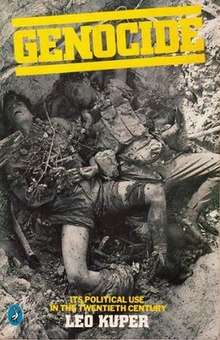Genocide: Its Political Use in the Twentieth Century
Genocide: Its political use in the Twentieth Century is a book by the sociologist Leo Kuper, about genocide.
 First edition | |
| Author | Leo Kuper |
|---|---|
| Published |
|
| ISBN | 9780300031201 1983 Yale University Press reprint |
| Website | |
The historical examples studied include the Armenian Genocide, the Holocaust, the 1971 Bangladesh Genocide, and the Burundian Genocide of 1972.[1]
Reception
Genocide was reviewed in a number of periodicals, including The New York Times[2] and the Virginia Quarterly Review.[3]
It is widely cited[4] and is included on reading lists for related courses of study at several universities.[5][6][7][8][9]
gollark: +<insult]
gollark: Oh, BEE YOU Epicbot.
gollark: +<insult
gollark: ""moderator"", "hi".
gollark: The difference between complaining about *police* generally as opposed to people of some *race* is that police choose to be police. And probably do have more shared attributes, given that they all do the same job in similar institutions.
References
- Kuper, Leo (1 August 1983). "Genocide: Its Political Use in the Twentieth Century". Yale University Press – via Google Books.
- "When People Kill A People". NYTimes.com. 1982-03-28. Retrieved 2016-12-12.
- Alison, Jane. "Notes on Current Books, Summer 1982". VQR Online. Retrieved 2016-12-12.
- "Google Scholar". Scholar.google.co.uk. Retrieved 2016-12-12.
- "Holocaust and Genocide Recommended Readings". Faculty.webster.edu. Retrieved 2016-12-12.
- "What we're reading | MSc in Global Crime, Justice and Security | LLM / MSc | Postgraduate | Edinburgh Law School". Law.ed.ac.uk. Retrieved 2016-12-12.
- "NU-L252-20001-16 - Genocide (Semester 1 & 2)". University of Salford. Archived from the original on 2016-09-18.
- "Knowlton, J". Users.sussex.ac.uk. 2002-01-30. Retrieved 2016-12-12.
- "University of Sussex". Users.sussex.ac.uk. Retrieved 2016-12-12.
This article is issued from Wikipedia. The text is licensed under Creative Commons - Attribution - Sharealike. Additional terms may apply for the media files.